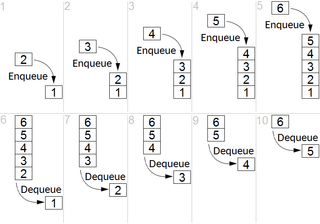 W
WIn computer science, inter-process communication or interprocess communication (IPC) refers specifically to the mechanisms an operating system provides to allow the processes to manage shared data. Typically, applications can use IPC, categorized as clients and servers, where the client requests data and the server responds to client requests. Many applications are both clients and servers, as commonly seen in distributed computing.
 W
WAmazon Simple Queue Service is a distributed message queuing service introduced by Amazon.com in late 2004. It supports programmatic sending of messages via web service applications as a way to communicate over the Internet. SQS is intended to provide a highly scalable hosted message queue that resolves issues arising from the common producer-consumer problem or connectivity between producer and consumer.
 W
WAvro is a row-oriented remote procedure call and data serialization framework developed within Apache's Hadoop project. It uses JSON for defining data types and protocols, and serializes data in a compact binary format. Its primary use is in Apache Hadoop, where it can provide both a serialization format for persistent data, and a wire format for communication between Hadoop nodes, and from client programs to the Hadoop services. Avro uses a schema to structure the data that is being encoded. It has two different types of schema languages; one for human editing and another which is more machine-readable based on JSON.
 W
WIn computer networking, telecommunication and information theory, broadcasting is a method of transferring a message to all recipients simultaneously. Broadcasting can be performed as a high-level operation in a program, for example, broadcasting in Message Passing Interface, or it may be a low-level networking operation, for example broadcasting on Ethernet.
 W
WCelery is an open source asynchronous task queue or job queue which is based on distributed message passing. While it supports scheduling, its focus is on operations in real time.
 W
WClient–server model is a distributed application structure that partitions tasks or workloads between the providers of a resource or service, called servers, and service requesters, called clients. Often clients and servers communicate over a computer network on separate hardware, but both client and server may reside in the same system. A server host runs one or more server programs, which share their resources with clients. A client does not share any of its resources, but it requests content or service from a server. Clients, therefore, initiate communication sessions with servers, which await incoming requests. Examples of computer applications that use the client-server model are email, network printing, and the World Wide Web.
 W
WCMS Pipelines implements the pipeline concept under the VM/CMS operating system. The programs in a pipeline operate on a sequential stream of records. A program writes records that are read by the next program in the pipeline. Any program can be combined with any other because reading and writing is done through a device independent interface.
 W
WFIFO – an acronym for first in, first out – in computing and in systems theory, is a method for organising the manipulation of a data structure – often, specifically a data buffer – where the oldest (first) entry, or 'head' of the queue, is processed first.
 W
WMessage passing is an inherent element of all computer clusters. All computer clusters, ranging from homemade Beowulfs to some of the fastest supercomputers in the world, rely on message passing to coordinate the activities of the many nodes they encompass. Message passing in computer clusters built with commodity servers and switches is used by virtually every internet service.
 W
WIn Unix-like computer operating systems, a pipeline is a mechanism for inter-process communication using message passing. A pipeline is a set of processes chained together by their standard streams, so that the output text of each process (stdout) is passed directly as input (stdin) to the next one. The second process is started as the first process is still executing, and they are executed concurrently. The concept of pipelines was championed by Douglas McIlroy at Unix's ancestral home of Bell Labs, during the development of Unix, shaping its toolbox philosophy. It is named by analogy to a physical pipeline. A key feature of these pipelines is their "hiding of internals". This in turn allows for more clarity and simplicity in the system.
 W
WIn computer science, shared memory is memory that may be simultaneously accessed by multiple programs with an intent to provide communication among them or avoid redundant copies. Shared memory is an efficient means of passing data between programs. Depending on context, programs may run on a single processor or on multiple separate processors.
 W
WIn computer science, a stream is a sequence of data elements made available over time. A stream can be thought of as items on a conveyor belt being processed one at a time rather than in large batches.